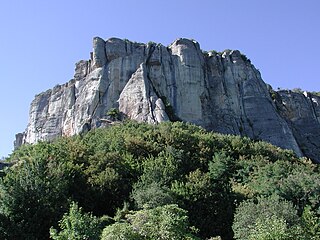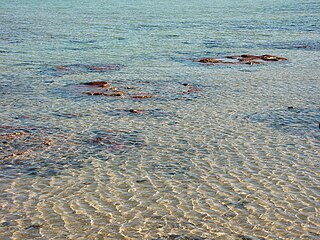Related Research Articles

Sedimentary rocks are types of rock that are formed by the accumulation or deposition of mineral or organic particles at Earth's surface, followed by cementation. Sedimentation is the collective name for processes that cause these particles to settle in place. The particles that form a sedimentary rock are called sediment, and may be composed of geological detritus (minerals) or biological detritus. The geological detritus originated from weathering and erosion of existing rocks, or from the solidification of molten lava blobs erupted by volcanoes. The geological detritus is transported to the place of deposition by water, wind, ice or mass movement, which are called agents of denudation. Biological detritus was formed by bodies and parts of dead aquatic organisms, as well as their fecal mass, suspended in water and slowly piling up on the floor of water bodies. Sedimentation may also occur as dissolved minerals precipitate from water solution.

Breccia is a rock composed of large angular broken fragments of minerals or rocks cemented together by a fine-grained matrix.

Conglomerate is a clastic sedimentary rock that is composed of a substantial fraction of rounded to subangular gravel-size clasts. A conglomerate typically contains a matrix of finer-grained sediments, such as sand, silt, or clay, which fills the interstices between the clasts. The clasts and matrix are typically cemented by calcium carbonate, iron oxide, silica, or hardened clay.

A pelite or metapelite is a metamorphosed fine-grained sedimentary rock, i.e. mudstone or siltstone. The term was earlier used by geologists to describe a clay-rich, fine-grained clastic sediment or sedimentary rock, i.e. mud or a mudstone, the metamorphosed version of which would technically have been a metapelite. It was equivalent to the now little-used Latin-derived term lutite. A semipelite is defined in part as having similar chemical composition but being of a crystalloblastic nature.

Clastic rocks are composed of fragments, or clasts, of pre-existing minerals and rock. A clast is a fragment of geological detritus, chunks, and smaller grains of rock broken off other rocks by physical weathering. Geologists use the term clastic to refer to sedimentary rocks and particles in sediment transport, whether in suspension or as bed load, and in sediment deposits.

The Roxbury Conglomerate, also informally known as Roxbury puddingstone, is a name for a rock formation that forms the bedrock underlying most of Roxbury, Massachusetts, now part of the city of Boston. The bedrock formation extends well beyond the limits of Roxbury, underlying part or all of Quincy, Canton, Milton, Dorchester, Dedham, Jamaica Plain, Brighton, Brookline, Newton, Needham, and Dover. It is named for exposures in Roxbury, Boston area. It is the Rock of the Commonwealth in Massachusetts.

One of the classic locations for the study of Triassic sandstones in the UK is at Alderley Edge in Cheshire. Numerous scientists from the early 19th century up to the present day have studied the area and it is a popular field site for universities around the UK.

Calcarenite is a type of limestone that is composed predominantly, more than 50 percent, of detrital (transported) sand-size, carbonate grains. The grains consist of sand-size grains of either corals, shells, ooids, intraclasts, pellets, fragments of older limestones and dolomites, other carbonate grains, or some combination of these. Calcarenite is the carbonate equivalent of a sandstone. The term calcarenite was originally proposed in 1903 by Grabau as a part of his calcilutite, calcarenite and calcirudite carbonate classification system based upon the size of the detrital grains composing a limestone. Calcarenites can accumulate in a wide variety of marine and non-marine environments. They can consist of grains of carbonate that have accumulated either as coastal sand dunes (eolianites), beaches, offshore bars and shoals, turbidites, or other depositional settings.
Psammite is a general term for sandstone. It is equivalent to the Latin-derived term arenite and is commonly used in various publications to describe a metamorphosed sedimentary rock with a dominantly sandstone protolith. In Europe, this term was formerly used for a fine-grained, fissile, clayey sandstone. Pettijohn gives the following descriptive terms based on grain size, avoiding the use of terms such as "clay" or "argillaceous", which carry an implication of chemical composition:
Lutite is old terminology, which is not widely used, by Earth scientists in field descriptions for fine-grained, sedimentary rocks, which are composed of silt-size sediment, clay-size sediment, or a mixture of both. When mixed with water lutites often disintegrate into mud. Because this is a field term, there is a lack of any precise definition for it based upon specific grain-size characteristics. Lutites include a variety of fine-grained sedimentary rocks, including calcisiltite, calcilutite, claystone, mudstone, shale, and siltstone. It is equivalent to the term mudstone and the Greek-derived term pelite. Lutite was first used in 1904 by Grabau, who derived it from lutum, the Latin word for mud. He also proposed a number of prefixes to be used with and attached to "lutite" in order to designate various types of lutites. None of these prefixes are used by Earth scientists nowadays.
Psephite is either a sediment or sedimentary rock composed of fragments that are coarser than sand and which are enclosed in a matrix that varies in kind and amount. It is equivalent to a rudite. Shingle, gravel, breccia, and especially conglomerate, would all be considered psephites. It is equivalent to the Latin-derived term rudite. Psephite is more commonly used for a metamorphosed rudite.
This glossary of geology is a list of definitions of terms and concepts relevant to geology, its sub-disciplines, and related fields. For other terms related to the Earth sciences, see Glossary of geography terms.

A cobble is a clast of rock defined on the Udden–Wentworth scale as having a particle size of 64–256 millimeters (2.5–10.1 in), larger than a pebble and smaller than a boulder. Other scales define a cobble's size differently. A rock made predominantly of cobbles is termed a conglomerate. Cobblestone is a building material based on cobbles.

Shallow water marine environment refers to the area between the shore and deeper water, such as a reef wall or a shelf break. This environment is characterized by oceanic, geological and biological conditions, as described below. The water in this environment is shallow and clear, allowing the formation of different sedimentary structures, carbonate rocks, coral reefs, and allowing certain organisms to survive and become fossils.
Calcirudite is a type of limestone that is composed predominantly, more than 50 percent, of carbonate grains that are larger in size than sand. The grains can consist of either fragments of fossils, fragments of older limestones and dolomites, other carbonate grains, or some combination of these. The term calcirudite was originally proposed in 1903 by Grabau as a part of his calcilutite, calcarenite and calcirudite classification system based upon the size of the detrital grains composing a limestone. Depending on roundness of the grains, calcirudite is the carbonate equivalent of either a breccia, in the case of predominantly angular grains, or conglomerate, in the case of predominantly rounded grains. Calcirudites can accumulate in a wide variety of coastal, lacustrine, and marine environments.

The Bass Formation, also known as the Bass Limestone, is a Mesoproterozoic rock formation that outcrops in the eastern Grand Canyon, Coconino County, Arizona. The Bass Formation erodes as either cliffs or stair-stepped cliffs. In the case of the stair-stepped topography, resistant dolomite layers form risers and argillite layers form steep treads. In general, the Bass Formation in the Grand Canyon region and associated strata of the Unkar Group-rocks dip northeast (10°–30°) toward normal faults that dip 60+° toward the southwest. This can be seen at the Palisades fault in the eastern part of the main Unkar Group outcrop area. In addition, thick, prominent, and dark-colored basaltic sills intrude across the Bass Formation.

Hainan Island, located in the South China Sea off the Chinese coast and separated from mainland China by the Qiongzhou Strait, has a complex geological history that it has experienced multiple stages of metamorphism, volcanic and intrusive activities, tectonic drifting and more. The oldest rocks, the Proterozoic metamorphic basement, are not widely exposed, but mostly found in the western part of the Island.

The geology of Uzbekistan consists of two microcontinents and the remnants of oceanic crust, which fused together into a tectonically complex but resource rich land mass during the Paleozoic, before becoming draped in thick, primarily marine sedimentary units.

The Sergipe-Alagoas Basin is a continental margin basin in the Sergipe and Alagoas states of northeastern Brazil, about 20 to 50 kilometres wide onshore, but with its widest extension offshore, more precisely 13,000 km2 onshore and 40,000 km2 offshore. In general, "Sergipe-Alagoas Basin" refers to the Sergipe and Alagoas sub-basins, but it also consists of the Jacuípe and Cabo sub-basins. Studies of the basin's geology date back to the first half of the 19th century, when J. Henderson in 1821 published preliminary notes on the region's geology.
References
- ↑ Grabau, A.W. (1904) On the classification of sedimentary rocks. American Geologist. vol. 33, pp. 228-247.
- ↑ rudus . Charlton T. Lewis and Charles Short. A Latin Dictionary on Perseus Project .
- ↑ U.S. Bureau of Mines Staff (1996) Dictionary of Mining, Mineral, & Related Terms. Report SP-96-1, U.S. Department of Interior, U.S. Bureau of Mines, Washington, D.C.
- ↑ Neuendorf, K.K.E., J.P. Mehl, Jr., and J.A. Jackson, J.A., eds. (2005) Glossary of Geology (5th ed.). Alexandria, Virginia, American Geological Institute. 779 pp. ISBN 0-922152-76-4
- ↑ Pettijohn F. J. (1975), Sedimentary Rocks, Harper & Row, ISBN 0-06-045191-2